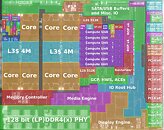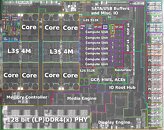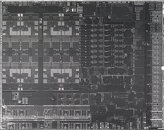Friday, June 19th 2020

AMD "Renoir" Die Annotation Raises Hopes of Desktop Chips Featuring x16 PEG
VLSI engineer Fritzchens Fritz, famous for high-detail EM photography of silicon dies and annotations of them, recently published his work on AMD's 7 nm "Renoir" APU silicon. His die-shots were annotated by Nemez aka GPUsAreMagic. The floor-plan of the silicon shows that the CPU component finally dwarfs the iGPU component, thanks to double the CPU cores over the previous-gen "Picasso" silicon, spread over two CCXs (compute complexes). The CCX on "Renoir" is visibly smaller than the one on the "Zen 2" CCDs found in "Matisse" and "Rome" MCMs, as the L3 cache is smaller, at 4 MB compared to 16 MB. Being MCMs with disintegrated memory controllers, it makes more sense for CCDs to have more last-level cache per CCX.
We also see that the iGPU features no more than 8 "Vega" NGCUs, so there's no scope for "Renoir" based desktop APUs to feature >512 stream processors. AMD attempted to compensate for the NGCU deficit by dialing up engine clocks of the iGPU by over 40% compared to those on "Picasso." What caught our eye in the annotation is the PCI-Express physical layer. Apparently the die indeed has 20 PCI-Express lanes besides an additional 4 lanes that can be configured as two SATA 6 Gbps ports thanks to SerDes flexibility.This would mean that "Renoir" can finally spare 16 lanes toward PEG (PCI-Express graphics, or the main x16 slot on your motherboard), besides 4 lanes toward the chipset-bus, and the final four lanes allocated to the M.2 NVMe slot that's wired to the AM4 socket, on a typical desktop platform. On the mobile platforms, "Renoir" processors spare no more than 8 lanes toward PEG (discrete graphics), including when paired with discrete GPUs such as the GeForce RTX 2060 (mobile), which is capable of gen 3.0 x16. Previous generation desktop APUs such as "Picasso" and "Raven Ridge" spare no more than 8 PCIe gen 3.0 lanes toward PEG, even on the desktop platform. x16 PEG capability would bolster the credentials of desktop "Renoir" processors for premium gaming PC builds, using some of the top SKUs such as the Ryzen 7 4700G.
Sources:
Fritzchens Fritz (Flickr), Nemez (Twitter)
We also see that the iGPU features no more than 8 "Vega" NGCUs, so there's no scope for "Renoir" based desktop APUs to feature >512 stream processors. AMD attempted to compensate for the NGCU deficit by dialing up engine clocks of the iGPU by over 40% compared to those on "Picasso." What caught our eye in the annotation is the PCI-Express physical layer. Apparently the die indeed has 20 PCI-Express lanes besides an additional 4 lanes that can be configured as two SATA 6 Gbps ports thanks to SerDes flexibility.This would mean that "Renoir" can finally spare 16 lanes toward PEG (PCI-Express graphics, or the main x16 slot on your motherboard), besides 4 lanes toward the chipset-bus, and the final four lanes allocated to the M.2 NVMe slot that's wired to the AM4 socket, on a typical desktop platform. On the mobile platforms, "Renoir" processors spare no more than 8 lanes toward PEG (discrete graphics), including when paired with discrete GPUs such as the GeForce RTX 2060 (mobile), which is capable of gen 3.0 x16. Previous generation desktop APUs such as "Picasso" and "Raven Ridge" spare no more than 8 PCIe gen 3.0 lanes toward PEG, even on the desktop platform. x16 PEG capability would bolster the credentials of desktop "Renoir" processors for premium gaming PC builds, using some of the top SKUs such as the Ryzen 7 4700G.



26 Comments on AMD "Renoir" Die Annotation Raises Hopes of Desktop Chips Featuring x16 PEG
Sure, they've ramped clocks up but most of the laptops reviewed so far aren't sustaining those clocks, so really it's still the same Vega CUs as it was in Raven ridge and the GPU clocks are still at the mercy of the power budget and RAM bandwidth, but now we have 3 fewer of them and Tiger lake early silicon is already outperforming it on beta drivers, apparently.
As for having 20PCIe lanes - What's the point? Anyone wanting to run a dGPU will just buy a 3700X instead and enjoy the superior performance of more cache and even more PCIe lanes.
If it were me designing the APU I would have thrown out the die area wasted on 20 PCIe lanes and used it to increase the CU count to 12 or 15 instead.
Gigabyte for ex. B550I AORUS PRO AX:
Have you even took a glimpse at the die? 8 Pcie lanes barely take the space of one CU.
Also how do you know Renoir will be worse at gaming? Let's wait for benchmarks.
not an integrated part
Graphics CU's consume too much area, seeing the APU without the GPU (which includes the CU (PS other GPU logics like the ROB), Media & Display Engines and the Display PHY's), they can't reduce the size of the CU, it's the easier part to use lower CU's with higher clocks than more CU's with lower clocks.
Look:
www.tomshardware.com/news/amd-ryzen-4000-renoir-desktop-benchmarks
Amd/comments/c7ejdf
and how exactly do you suggest I compare it to 3700x ?
Whilst it's true that Renoir's launch has been hampered by COVID, the earliest benchmarks acutally go back as far as February, with more concrete stuff appearing in April and May seeing general availability of several models of Renoir laptop. I'm annoyed slightly that the 4800U with LPDDR4X hasn't been reviewed yet, but I don't really think it matters at this point. Vega8 isn't good enough to make a meaningful upgrade over Raven Ridge and anyone wanting actuall GPU performance is going to have to wait until the next generation or settle for a dGPU; The benchmarks of 4700U + DDR4-3200 are within 20% of my own 2700U using CL14 DDR4-2400 and a 22W power limit (stock was 20W)
As for pre-release Tiger Lake vs current APUs? 30fps on beta/pre-release drivers vs 25fps for Renoir.
Like it or not, AMD APUs have always been slightly short of achieving AAA gaming at reasonable native-res 30fps. Renoir is such a sidegrade that AMD still haven't quite achieved that basic goal and now it's looking like Intel will beat them to it after AMD have been tantalising gamers with "almost enough" for three years. AMD had all the ingredients to bake a great APU and failed this generation. It's a CPU first and the GPU is clearly an afterthought with cut-down specs and less die area than before. I'm going to enjoy watching Intel kick their ass because as much as I want AMD to succeed, they've really fudged their APUs this generation and they need a kick up the ass.
Put as much energy into finding a good comparison point as you do arguing on tech forums and I'm sure you'll find a way.
What would happen If they kept 3CU or added another one for a total of 12CU? It would clock even lower than a 8CU IGP within a limited TDP, because 11-12CU consumes more power than 8CU. The limit is still powerbudget and bandwidth so why bother adding or keeping more CU If It won't significantly increase performance? If they resolve the bandwidth limit, then they can increase the CU count and set TDP higher and for 15W TDP there will be a cutdown version.
- be faster than the competition
- not be slower than last gen APUs
- not threaten their discrete GPU sales
As an AMD fan for more than 20 years, I hope Intel to teach them a lesson.You would totally cripple the expandability options of the motherboard with only 8 lanes.
As for 20 PCIE lanes, its something for people who are interested in it, more is always better I guess. There really isn't a reason to dunk on it IMO, its better than the x8 we where fed previously
As for the 3700X vs the (potentially named) 4700G, the biggest deficit of the 3700X as well as other Zen 2 CPUs is the core to core latency, which wouldn't be present here,. See the 3100 to 3300X differences, assuming that the difference of moving to a single CCX will benefit the (potential) 4700G, it should perform the same, if not better.
My point is AMD may have determined that the APU performance provided by 8 CU Renoir is the peak that can be achieved with DDR4 which is why they cut it down to 8CU max, saving silicon for more CPU cores.
Regarding Sideport memory, I remember that as I had a mobo with it (256mb, 32 bit from memory). But again, you miss my point, it is not a technical challenge that prevents them, it is an economic one. AMD is providing more iGPU power than people are willing to pay for, so it makes no sense to increase mobo cost to make a faster iGPU when people who care get a dGPU and people that don't are happy with what is provided (which is double what Intel are currently providing, considering tiger lake isn't released yet).
And no, the argument wasn't irrelevant. You just didn't understood it. Even with slower Zen+ cores the difference between a 3200G and a 3400G is there, even in games where not more than 4 cores/threads are needed. This means that 11 CUs in Renoir could offer more performance than 8 CUs. And because of that 65W TDP that you mention, the iGPU in a desktop Renoir could really shine. But then, who needs an RX 550? Probably no one.
Sideport memory could be used in mini ITX and micro ATX motherboards that where going to be used in mini PCs without discrete graphics.
Look, you make a lot of assumptions to support your point of view, even about what people want. No problem with that. But assumptions are not facts and no, what people need is not what you believe they need. And people sometime know what they need, but they don't know how to get it. So you see examples where someone is going out and buys a GT 730 with 4GB DDR3 memory on a 64bit data bus, to play games because the iGPU is slow.
Features like sideport memory are there as an option. Offering sideport memory doesn't mean that every motherboard out there will rush to implement it making it immediately more expensive. You are wrong here, again.
P.S. If Intel manages to win the iGPU battle and next AMD APUs come with 12 CUs, sideport memory and Hybrid graphics, then let's see what you will say then.
"Intel got filthy rich by serving up hot garbage for decades, let's see if it works for us!"
- AMD
No one said that Zen 2 cores are the only reason for the extra performance from those 8 CUs. I don't have time to keep repeating what I wrote, because you try to force your own conclusions while twisting the meaning of my posts. I am going to ignore these kind of conclusions and tricky questions from now and on.I am not going to keep repeating myself.No one will point the finger at you if you permit someone else to have a different opinion than yours. I believe that it has been already proven that the bandwidth is enough to feed 11 CUs for low/mid settings 720p/1080p gaming, you believe it's not enough. OK.11CUs are NOT a 2080 Ti. I understand what you mean, but when you feel the need to use the fastest card in the world to make a point, I don't buy it.Let's agree that we disagree here."Sound technical decision" to lose the iGPU advantage. OK.